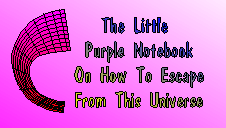
749. The Nirvana
Process
Many of us who are studying the art of asking the right question at the right moment are calling the combination of these questions a 'rundown'.
This term has a negative connotation and will not be used for the following sequence of processes which has been reportedly used by Gotamo Siddharto to enter what he called 'nibbâna'.
It is not a single process but rather a sequence. Its result, (or 'end phenomenon' as some people call it) is not just 'enlightening' - it goes beyond this Universe - beyond 'enlightening'.
This sequence has been described in detail in a lengthy discourse (Pali: sutta). It appears as a chain of classic 'static' processes and these would have to be applied as such in a setup with a facilitator.
However, the true power
of this sequence is that it contains _dynamic_ processes, at least when
done in a _solo_ processing setup. A dynamic process does not follow the
rules of a
communication cycle
anymore since it 'shifts' its question without discrete acknowlegdements.
An analogy could be
the tuning of a radio station. A static ('traditional') process would be
like a digital keyboard in which a frequency has to be entered that then
would tune in a
station. A 'dynamic'
tuning happens by just rotating the tuner dial until a station becomes
discernible. (In the analogy, this is the 'old-fashioned' way.)
The importance of a dynamic process is that it can be applied by the super-consciousness without involving 'rational' (discrete) thinking activities.
In this case, and perhaps in _only_ this case, the first person singular ("I") should be used instead of the third person ("You") because one is processing the very last fragments of case'. Also, the process is concept-oriented rather than dependent on the semantics of the questions. In other words, run the concepts instead of verbal questions. Ala
After distilling the structure of the sequence of processes that lead Gotamo to enter nirvana, and after adding a 'safety net', the following elements emerge:
{begin setup}
What would
have to happen that I would enjoy this [domain] ?
What would
not have to happen that I would enjoy this [domain] ?
What would
happen if I would enjoy this [domain] ?
What would
not happen if I would enjoy this [domain] ?
{end setup}
{begin nibbâna-process}
Is there a [domain] that is more enjoyable than this [domain] ?
How does
it feel enjoying this more enjoyable [domain] ?
If thoughts/feelings
of the previous domain arise, are they more
enjoyable
or less enjoyable? ( if necessary, run {setup} again).
{end nibbâna-process}
Again, this is the actual process that Gotamo reportedly used to enter the domain of 'nibbâna', commonly called 'nirvâna'.
In the historical account he started out at the domain of 'boundless space'. This domain is entered upon staying in the attitude of 'upekkha' (equanimity) for a prolonged time.
The attitude (tone level) of uppekkha is achieved by a sustained attitude of 'mudita' (sharing joy of others) which is following the attitude of 'karu.na' (lit. 'caring' and _not_ 'compassion' as frequently translated), which in turn follows the attitude of 'metta' (spiritual love).
These attitudes and
states are located on an 'upwards spiral' and are automatically entered
once a person increases the 'frequency' of their attitude. Some immensily
popular spiritual
leaders claim to be
staying on 'compassion' for 90% of a day. Whatever they are doing, they
are apparently not entering 'karu.na' since they would necessarily rise
to 'muditâ' after a while or 'drop' to 'mettâ' - boundless
love.
The progression of states of the mind is a reflection of the structure of this Universe and is thus independent of subjective evaluations. Just as raising an audio frequency from the tone 'A' (440 Hertz) will yield the tones, 'B', 'C', and so forth, this progression is an inherent structural property.
And, given the law of continuity (or, better, the law of the impossibility of discontinuities in this Universe), these stages have to be passed sequentially in order to exit this Universe.
Fortunately, it is a way of increasing joy and happiness.
Which was (and for many still is) the hallmark of Gotamo Siddharto's teachings:
"Through Happiness to Happiness!".